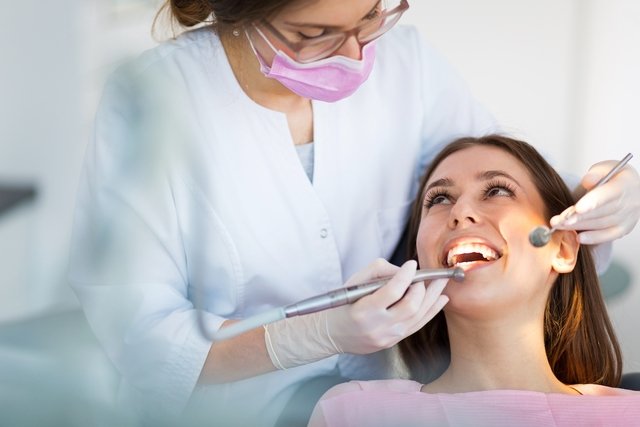Exodontia is the surgery for tooth extraction indicated in cases of severe tooth decay, broken teeth, removal of wisdom teeth or baby teeth, but also for the removal of teeth for treatment with dental braces.
This type of treatment can be carried out on one or more teeth and on any tooth in the upper or lower dental arch, such as the molar, premolar, canine, incisor, baby tooth or wisdom teeth, according to the dentist’s recommendations.
Exodontia is carried out using local anesthesia, in the dentist’s office, requiring some care after removal, such as applying cold compresses to the face, using medicine to relieve pain and avoiding eating very hard or hot foods, for example.

When is indicated
Exodontics is indicated for:
- Severe tooth decay, when it is not possible to recover the tooth;
- Broken tooth at the root or crown;
- Removal of the residual root or root remains of a fractured tooth;
- Removal of the wisdom tooth when it does not have enough space to emerge, has cavities or is in an incorrect position;
- Cracked or cracked tooth, when the root is very compromised;
- Trauma to the tooth that affects the root;
- Removal of baby teeth, in some cases;
- Teeth with root canals, which were unsuccessful with treatment.
Furthermore, extraction may be indicated to open spaces or remove excess teeth for treatment with dental braces or to prevent or correct occlusion problems.
Exodontics may also be indicated in cases of softening of teeth caused by gum disease such as severe periodontitis or gum abscesses.
Which doctor performs tooth extraction?
Exodontia is performed by a dentist or periodontist, which is a specialty of dentistry that takes care of the supporting and protective tissues of the teeth.
In addition, tooth extraction can also be carried out by an oral and maxillofacial surgeon.
If you would like an evaluation by an oral and maxillofacial surgeon, make an appointment in the nearest region:
Taking care of your health has never been easier!
How to prepare
To prepare for tooth extraction, it is important to inform the dentist:
- If you have health problems, such as high blood pressure, diabetes, kidney, liver, heart or thyroid disease, or a weakened immune system;
- If you have a history of endocarditis or are undergoing treatment for cancer;
- If you have heart valves or prostheses in any joint;
- If you are going to start treatment with bisphosphonate medicines, such as alendronate, ibandronate, pamidronate or zoledronic acid, for example;
- All medicines, vitamins, dietary supplements or natural products you use;
- If you are allergic to anesthetics or any other type of medicine or food.
Before carrying out the extraction, the dentist must request tests such as panoramic X-rays, in addition to a physical evaluation of the tooth and gums, and the use of antibiotics may be recommended a few days or hours before the procedure.
How it is made
Exodontia is performed by a dentist, periodontist or oral and maxillofacial surgeon in the office, using local anesthesia.
To perform a simple extraction, the dentist must follow a few steps:
- Apply local anesthesia, around the affected tooth so as not to feel pain. However, it is possible to feel pressure in the area during the procedure;
- Remove the gum from the toothor in some cases make a small cut in the gum;
- Loosen the tooth or cut the tooth to facilitate extraction;
- Remove the affected toothwith its own instruments for this;
- Clean and disinfect the tooth socketwhich is the cavity where the tooth is fixed;
- Give points at the site of tooth removal.
In addition, the dentist must bandage the area to prevent bleeding and encourage the formation of a clot at the site, which is important to promote healing.
Care after tooth extraction
After tooth extraction, some precautions are important, such as applying cold compresses to the face, on the side where the tooth was extracted, for a maximum of 10 minutes, a few times a day, during the first 24 hours after the procedure.
In addition, you should rest and avoid exertion for the first 24 hours and take the medicines recommended by your dentist, and you should also apply light pressure on the dressing for about 45 minutes to 1 hour, to avoid bleeding and allow the formation of a clot, which is important for healing.
It is also recommended to avoid eating very hard or hot foods, not smoking and not spitting or mouthwashing. See all the precautions you should take after tooth extraction.
What is recovery like?
Recovery from tooth extraction can take 7 to 10 days, which is the average healing time after tooth extraction.
However, this recovery time may vary depending on the complexity of the procedure, whether complications such as nerve damage occurred, and whether care recommendations were followed after tooth extraction.
Possible complications
Exodontia can cause complications such as pain, bleeding, bruising, swelling or infections.
Furthermore, if the blood clot dislodges, alveolitis may occur, which is the inflammation and infection of the tooth socket. Learn how to identify the symptoms of dry socket.
Other complications that can occur are damage to the teeth that are next to the removed tooth, fracture of the jaw or jaw, or nerve damage with a feeling of numbness in the lips, tongue or cheek that can be temporary or permanent.
Who shouldn’t do
Exodontia can be done by anyone, however, in some situations it may be necessary to postpone tooth extraction, such as:
- Treatment with chemotherapy, radiotherapy or bisphosphonates;
- Weakened immune system;
- Uncontrolled diabetes or high blood pressure;
- Uncontrolled epilepsy.
These health conditions must be evaluated by the dentist, and therefore, it is important to inform any type of health problem you have, so that the tooth extraction can be carried out safely and avoid the risk of complications.

Sign up for our newsletter and stay up to date with exclusive news
that can transform your routine!
Warning: Undefined array key "title" in /home/storelat/public_html/wp-content/plugins/link-whisper-premium/templates/frontend/related-posts.php on line 12
Warning: Undefined array key "title_tag" in /home/storelat/public_html/wp-content/plugins/link-whisper-premium/templates/frontend/related-posts.php on line 13



